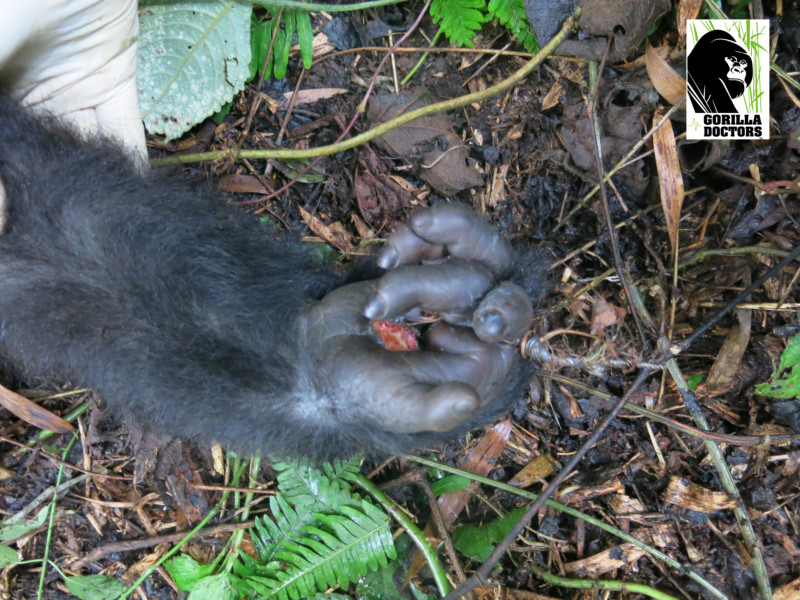Baby in Mapuwa Group Rescued From Snare
By Gorilla Doctors Staff on Tuesday, October 18th, 2016 in Blog.
By Dr. Eddy Kambale
We received a call from the Chief Warden in Virunga National Park, Democratic Republic of Congo on October 2 after an ensnared baby was seen in the Mapuwa group during routine monitoring by rangers and trackers.
The Mapuwa group consists of 22 gorillas, including 3 silverbacks (Mapuwa, Mvuyekure and Mambo), 1 blackback (Gourba), 6 adult females, 2 sub-adult males, 5 juveniles, and 5 babies.
During the visit, the rangers heard 3-year old Ndisetse crying and saw that he was falling behind the group. He had a large wire snare on his right hand. The rangers decided to cut the wire snare, but despite the 3 silverbacks being far away, they were not able to remove it from the hand, as Kanepo, Ndisetse’s mother, was watching them.
The next day, the Gorilla Doctors team (me and Dr. Martin) accompanied by 4 rangers, 3 porters, and 4 trackers, entered the forest. After one-and-a-half hours of trekking, we reached the group around 2 p.m. Ndisetse was still screaming, just as it was described in the reports from the previous day. He stayed near the silverback Mvuyekure, and was not using the injured arm. Kanepo also remained near, and would occasionally carry him on her back. As the mother stayed so close to Ndisetse, we decided that it was necessary to dart the mother as well as the baby at the same time.
Unfortunately it did not work that way, as both CO2-powered pistols malfunctioned (one was over-pressurizing and the second was leaking). In the end we managed to work with the over-pressurizing gun to dart the baby. We had another dart ready for the mother in case she came to pick up the anesthetized baby.
We darted Ndisetse, he let out a short cry, and Kanepo moved into the bush to hide. For the same reason, the silverback Mvuyekure came charging and stood near the baby: so we could not approach Ndisetse while he was already anesthetized. We were happy when we managed to move the silverback strategically away from the baby, but unfortunately mother Kanepo came to pick him up.
When she realized that the baby was not holding on as he would normally, she dropped him, which allowed us to get to Ndisetse to cut off the snare. The snare wire was very thick and tight, and it took us more than five minutes to remove.
The fingers were bound very tightly together, compromising the circulation to the fingertips – which can result in necrotized fingers if the intervention is delayed.
The three silverbacks came back and charged to protect the baby. Although they did not really interact directly with us, they were nearby, watching. We worked faster to clean and disinfect the wounds from the snare on the hand along with another on the elbow. We administered long-acting antibiotics and painkillers, and collected samples to analyze his health status.
We reversed the anesthesia and I carried Ndisetse towards the group. When he woke up, he cried, and immediately silverback Mvyekure appeared, but ran past the baby to look for the source of danger. Mother Kanepo followed Mvyekure, but stopped at Ndisetse and placed him on her back before running into the bush.
The silverback Mvuyekure has a special story of his own: He was poached as a baby but rescued by the Chief Warden. Fortunately, rangers and trackers remembered the group where he was from and they decided to reintroduce him into the group on the same day.
They did so very successfully: now he is the dominant silverback managing 22 gorillas, including little Ndisetse.


 Donate
Donate





